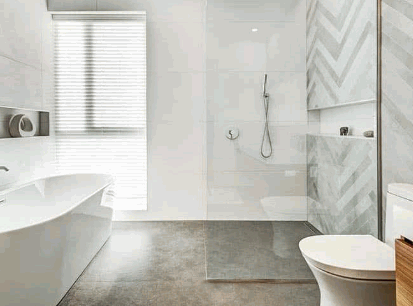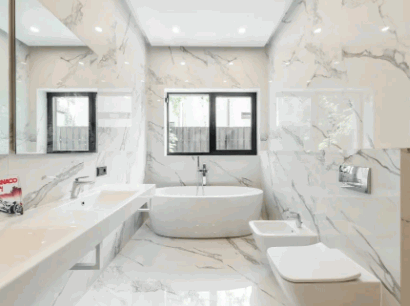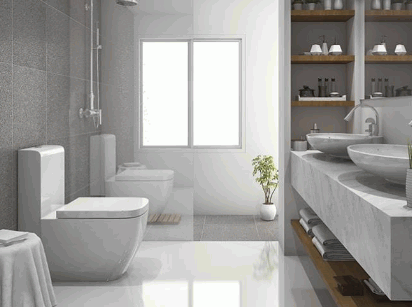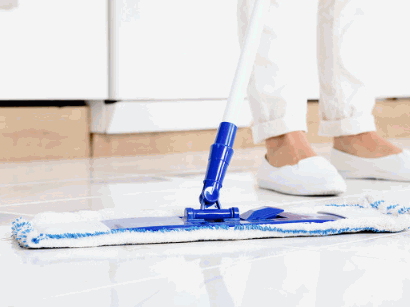Epoxy flooring is a popular choice for many homeowners due to its durability, easy maintenance, and aesthetic appeal.
But can epoxy flooring be used in bathrooms? We explore the benefits of epoxy flooring, how it differs from other types of flooring, and the factors to consider before using it in bathrooms.
We also discuss the potential risks, the process of installation, and maintenance tips to keep your bathroom floor looking its best.
Read on to learn everything you need to know about using epoxy flooring in bathrooms.

Epoxy flooring is a type of flooring that consists of multiple layers of epoxy resin applied to a floor surface. It is known for its durability, resistance to stains, and ability to create a high-gloss finish.
The composition of epoxy flooring typically involves a base layer, a coloured epoxy layer, and a protective topcoat. The installation process starts with thorough cleaning and preparation of the existing floor to ensure proper adhesion. Once the floor is prepped, the epoxy resin is mixed and applied evenly using rollers or squeegees, followed by the topcoat for added protection.
Some of the key advantages of epoxy flooring include its resistance to chemicals, seamless finish that makes it easy to clean, and the range of design options available such as colour flakes or metallic pigments. Its durability makes it suitable for high-traffic areas like garages, industrial spaces, and commercial buildings.

Epoxy flooring differs from other types of flooring due to its exceptional adhesion properties, tough finishes, and resistance to chemicals and water. Unlike traditional tile flooring, epoxy provides a seamless and durable surface.
Epoxy floor coatings are renowned for their unmatched adhesion, which allows them to bond seamlessly to existing flooring materials, creating a strong and long-lasting surface. The toughness of epoxy flooring is particularly impressive, as it can withstand heavy foot traffic, impacts, and abrasions without showing signs of wear.
Another distinguishing feature of epoxy is its resistance to various chemicals and moisture, making it an ideal choice for areas prone to spills and frequent cleaning. Epoxy flooring offers a wide range of finishes, from high-gloss options to decorative flakes or metallic effects, allowing for customisation and versatility in design.
Epoxy flooring offers numerous benefits, including exceptional durability, low maintenance requirements, and unparalleled design freedom to customise the look of the floor.
One of the significant advantages of epoxy flooring is its remarkable durability, providing a long-lasting solution for both residential and commercial spaces. This type of flooring is highly resistant to impact, chemicals, stains, and surface abrasion, making it ideal for high-traffic areas.
Epoxy floors are also known for their design flexibility, allowing you to create a unique and personalised look through a variety of colours, patterns, and finishes. Maintaining epoxy flooring is a breeze - with its seamless surface, cleaning becomes effortless, and the floor remains looking new and vibrant for years.

Epoxy flooring can be used in bathrooms due to its water resistance and ease of cleaning. Its seamless application also makes it suitable for damp areas like bathrooms.
In terms of bathrooms, moisture, and constant cleaning are common challenges that need durable solutions. Epoxy flooring not only withstands water exposure but is also highly resistant to stains and chemicals, making it an ideal choice for bathrooms.
The seamless nature of epoxy application eliminates grout lines, which are prone to mould and mildew growth in traditional tile flooring. This not only enhances the overall cleanliness of the bathroom but also simplifies maintenance.
Installing epoxy flooring in a bathroom involves a step-by-step process that includes proper surface preparation, application of the epoxy coating, and adequate curing time. This ensures a long-lasting, hygienic flooring solution that can transform the look and functionality of any bathroom.
Before using epoxy flooring in bathrooms, it is essential to consider factors such as slip resistance, safety measures, and ensuring the waterproof properties of the flooring.
Slip resistance plays a crucial role in bathroom settings to prevent accidents due to slippery surfaces.
Safety measures should be prioritised to ensure a secure environment for household members and guests.
Waterproofing features are vital to protect the underlying structure from water damage, especially in areas prone to moisture. It is advisable to assess these factors comprehensively to guarantee the longevity and functionality of the epoxy flooring in bathrooms.
Discover more: Is Epoxy Flooring Expensive
Whilst epoxy flooring in bathrooms offers durability and water resistance, potential risks include maintenance requirements, repairs, and the longevity of the flooring in a damp environment.
One of the primary challenges of maintaining epoxy flooring in bathrooms is the need for regular cleaning to prevent the accumulation of moisture and bacteria. Any damages to the epoxy surface may require specialised repair techniques to ensure proper restoration. Although epoxy is known for its longevity, in a damp environment like a bathroom, it may be more susceptible to wear and tear over time, necessitating careful consideration of its maintenance and potential replacement.

Preparing a bathroom for epoxy flooring involves thorough cleaning, addressing necessary repairs, and proper surface preparation to ensure the adhesion of the epoxy coating.

To properly clean and prepare a bathroom floor for epoxy installation, begin by removing any existing coatings, ensuring adequate adhesion, applying the primer, and finally, the epoxy resin.
Before installing epoxy flooring in a bathroom, necessary repairs should be made to the existing floor, and preparations should include mixing the epoxy resin with the hardener and applying the top coat for protection.
One of the crucial steps in preparing for epoxy flooring is repairing any existing damage on the surface. This may involve fixing cracks, filling gaps, and ensuring a smooth and level base for the epoxy application.
Once the repairs are completed, the next significant task is mixing the epoxy resin with the hardener as per the manufacturer's instructions to achieve the desired chemical reaction for a durable and long-lasting finish.
After mixing the resin and hardener thoroughly, the application of the top coat is essential to provide an additional layer of protection against water, stains, and daily wear and tear.
The process of installing epoxy flooring in bathrooms involves using specific tools and materials, applying layers of epoxy resin, and allowing proper curing time for a seamless finish.
Before starting the installation, make sure to gather all the necessary tools and materials, including an epoxy resin kit, primer, roller brushes, squeegees, and safety equipment like gloves and goggles.
For the installation of epoxy flooring in bathrooms, essential tools and materials include the epoxy coating system, high-quality resin, hardener, and top coat for added durability and protection.
You will need tools such as a mixing paddle, squeegee, roller frame, and roller cover for application. Proper surface preparation is crucial, so don't forget cleaners, degreasers, and a concrete patching compound. To ensure a smooth finish, have sandpaper, a floor scraper, and a putty knife on hand. Quality products are key for a successful installation, so invest in a moisture meter, notched trowel, and a mixing bucket. Don't overlook safety gear like gloves, goggles, and a respirator.
Properly installing epoxy flooring in bathrooms involves mixing the epoxy components, applying the desired colours or patterns, and seeking professional assistance for a flawless finish.
Begin the installation process by thoroughly cleaning the bathroom floor surface to ensure proper adhesion of the epoxy. Next, mix the epoxy resin and hardener according to the manufacturer's instructions, ensuring proper ratios are maintained for a durable finish. Once the mixture is ready, use a roller to apply the epoxy evenly onto the floor, working in small sections to avoid uneven application.
For added customisation, consider utilising different colours or patterns to achieve a unique look for your bathroom space. Professional assistance can be invaluable in ensuring a smooth and professional application, especially for intricate designs or challenging layouts.
Maintaining and caring for epoxy flooring in bathrooms involves regular cleaning using mild detergents, avoiding harsh chemicals, and preserving the floor's attractive appearance.
It is important to sweep or vacuum the floor frequently to prevent dirt and debris from accumulating and causing scratches.
Placing rugs or mats at entry points can help protect the floor from excessive wear and tear.
You should also avoid dragging heavy furniture or sharp objects across the epoxy flooring, as this can cause scratches and damage. Consider resealing or recoating the floor every few years to maintain its shine and durability. By following these maintenance tips, you can extend the lifespan of your epoxy bathroom flooring and keep it looking pristine for years to come.
Cleaning and maintaining epoxy flooring in bathrooms involves using non-abrasive cleaners, exploring customisation options such as patterns, and enhancing the overall value of the floor through proper care.
In terms of selecting non-abrasive cleaners for epoxy flooring, it is crucial to avoid harsh chemicals that can damage the surface. Opt for gentle cleaners specifically designed for epoxy surfaces, or create a DIY solution using mild dish soap and water. Regular cleaning routines should include sweeping or vacuuming to remove debris and mopping with the chosen cleaner to maintain the floor's shine.
Customisation possibilities for epoxy flooring extend beyond simple colour choices. Consider incorporating decorative patterns, textured finishes, or even metallic accents to create a unique bathroom aesthetic. These customisation options not only add visual interest but also help to personalise the space according to individual preferences.
To increase the value of your epoxy flooring, implement preventive maintenance strategies such as placing mats at entryways to prevent scratches and avoiding dragging heavy furniture across the floor. Repair any damage promptly by consulting a professional to ensure proper care and preservation of the epoxy surface.

Understanding the dos and don'ts of epoxy flooring in bathrooms is crucial to maintaining its durability, ensuring the longevity of the system, and simplifying the upkeep process.
One of the key dos when it comes to epoxy flooring in bathrooms is to properly prepare the substrate before installation. This includes thorough cleaning, repairing any existing damage, and ensuring a smooth surface for the epoxy to adhere to. Additionally, regular cleaning and maintenance are essential to preserve the appearance and integrity of the flooring.
On the other hand, a major disadvantage is exposing the epoxy flooring to harsh chemicals that can degrade the material over time. It's also important to avoid abrasive cleaning tools that can scratch or damage the surface.